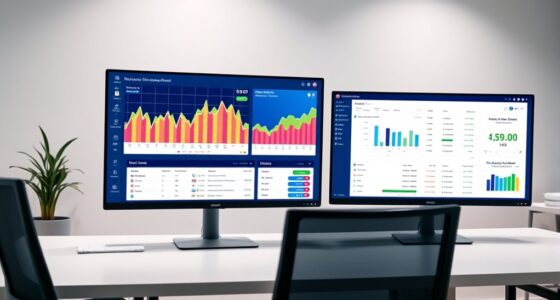High-risk merchant accounts are designed for businesses in industries with high chargebacks, fraud, or strict regulations. These accounts enable you to accept credit and debit card payments despite the challenges that come with riskier sectors like gambling or adult services. To get approved, you'll need to provide detailed financial statements, proof of business registration, and demonstrate financial stability. Expect higher processing fees and a longer application process. Maintaining low chargeback rates and demonstrating transparency can greatly improve your approval chances. There's much more to understand about maneuvering this landscape successfully, so let's explore further.
Key Takeaways
- High-risk merchant accounts cater to industries with elevated chargebacks and fraud rates, allowing them to accept credit and debit card payments.
- A detailed application process is necessary, including financial statements, tax returns, and proof of business registration for legitimacy verification.
- Approval chances greatly depend on credit scores, transaction history, and maintaining healthy cash reserves to demonstrate financial stability.
- Implementing effective risk management strategies, such as monitoring chargeback rates and enhancing customer service, is crucial for approval.
- Seek specialized payment processors that understand high-risk industries and compare fees, reserve requirements, and customer service reliability.
Understanding High-Risk Merchant Accounts

When you're running a business that falls into the high-risk category, understanding high-risk merchant accounts becomes essential. These accounts are tailored for industries like adult services, gambling, CBD products, and nutraceuticals, which often face higher chargebacks and fraud rates.
Unlike traditional payment processing, high-risk merchant accounts allow you to accept credit and debit card payments despite these challenges. To enhance your financial stability, it's important to establish a solid budget that accounts for the unique costs associated with high-risk transactions.
Obtaining one usually involves a more extensive application process. You'll need to submit detailed financial statements and documentation to prove your business operations. Pay attention to your credit score; it's a significant factor that can affect your approval chances.
High-risk merchant accounts typically incur higher processing fees, often starting at 1.5% plus interchange rates. Be prepared for potential reserve requirements as well, which are designed to mitigate financial risks.
To navigate this landscape effectively, consider utilizing fraud prevention tools. They can help you manage chargebacks and protect your revenue.
Understanding the intricacies of high-risk merchant accounts is essential for securing the payment processing you need while minimizing your overall business risk.
Characteristics of High-Risk Accounts

When you consider high-risk merchant accounts, it's important to recognize the specific industries that often fall into this category, like adult services and CBD products.
These businesses face unique risk assessment factors, including higher chargeback rates and fraud potential.
Additionally, the evolving landscape of technology, including the rise of AI Online Jobs, can create both opportunities and challenges for high-risk merchants.
Understanding these characteristics can help you navigate the complexities of managing a high-risk account effectively.
Industry Examples
High-risk merchant accounts are common in various industries, each characterized by unique challenges that elevate their risk profiles. Industries like adult entertainment, gambling, CBD products, e-cigarettes, and nutraceuticals often face higher levels of chargebacks and fraud, making them prime candidates for high-risk classification.
If you're a new business without a processing history or have poor credit, you might find yourself labeled as high-risk, especially if you've been on the MATCH list. Additionally, businesses operating in these sectors should be aware of their potential IRA investment strategy options that could help diversify their risks.
Furthermore, subscription-based services and companies heavily reliant on international sales are often deemed high-risk due to fluctuating regulations and customer chargeback rates.
Businesses operating in legal gray areas, such as those selling firearms or controversial dietary supplements, face scrutiny from payment processors, further heightening their risk status.
As a result, high-risk businesses typically encounter higher payment processing fees and longer application processes. You may also be subject to cash reserve requirements, which payment processors impose to mitigate potential risks.
Understanding these industry examples can help you navigate the complexities of securing a high-risk merchant account.
Risk Assessment Factors
Understanding the characteristics that define high-risk merchant accounts is essential for any business owner looking to navigate this challenging landscape. Several risk factors contribute to a business being classified as high-risk, and recognizing these can help you prepare for the underwriting process.
It's important to also consider how state-specific regulations, such as those regarding Wisconsin IRA withdrawals, can impact financial decisions and business operations.
- Industry Type: Businesses in sectors like adult services, gambling, and CBD products often face higher chargebacks and fraud rates.
- Credit Scores: Poor credit scores can signal financial risk, making it harder to secure a merchant account.
- MATCH List: If you've been flagged in the MATCH list, it's a significant red flag for payment processors.
- Business History: New businesses without a payment processing history are frequently viewed as high-risk due to their unproven track record in managing chargebacks and disputes.
Being aware of these factors can help you mitigate risks when applying for high-risk merchant accounts.
Payment processors may impose higher fees, demand cash reserves, and extend the application process to protect against potential losses. Understanding these dynamics will better equip you to manage your business bank account effectively.
Factors That Determine High-Risk Status

When evaluating whether your business is high-risk, several key factors come into play.
Industry classification, your financial stability, and the sales model you use can all impact your risk status.
For instance, businesses in sectors such as transportation or healthcare often face unique challenges that can influence their risk profile, such as efficient payment solutions that may be required for seamless operations.
Understanding these elements helps you navigate the complexities of securing a merchant account.
Industry Classification Criteria
In today's fast-paced market, certain industries automatically raise red flags for payment processors, leading to their classification as high-risk. If you're in one of these sectors, you might find it challenging to secure high-risk merchant accounts.
Understanding the complexities of how to get a divorce can provide insights into maneuvering through difficult situations, much like those faced by high-risk merchants. Here are some key factors that can determine high-risk status:
- Chargeback Rates: Industries with high chargeback rates, like gambling or e-cigarettes, face increased scrutiny.
- Payment Processing History: New businesses without an established record may be viewed as unreliable.
- Poor Credit Records: If your business has a history of poor credit or appears on the MATCH list, expect a tougher approval process.
- Nature of Products: Selling products with legal ambiguities or in highly regulated industries can elevate your risk profile.
Additionally, businesses involved in international sales often encounter more challenges due to varying regulations.
Understanding these industry classification criteria can help you navigate the complexities of merchant account approval, ensuring you're better prepared to address potential concerns from payment processors. Knowing where you stand can facilitate your journey toward a successful payment processing experience.
Financial Stability Assessment
Evaluating financial stability is an important part of determining whether your business falls into the high-risk category. Payment processors look closely at various factors, including your credit scores and transaction history. If you have poor credit scores or a history on the MATCH list, your high-risk status becomes more pronounced.
Additionally, understanding the benefits of merchant account credit processing can provide insights into how to enhance your financial profile for better approval chances.
New businesses often face challenges since they lack a proven processing history, making it difficult for processors to assess their financial reliability. Industries with fluctuating sales or those selling controversial products, like CBD or adult services, are also scrutinized for perceived financial instability.
High transaction volumes or subscription models can elevate your risk profile, as they may lead to increased chargeback rates and greater financial exposure.
To improve your chances of approval, it's vital to maintain healthy cash reserves and demonstrate a solid transaction history. Payment processors will evaluate your overall financial health based on detailed documentation and your ability to manage risks effectively.
Ultimately, understanding these factors can help you navigate the process and potentially secure a high-risk merchant account.
Sales Model Impact
Sales models play an essential role in determining whether your business falls into the high-risk category. If you rely on certain sales structures, you might face challenges in securing high-risk merchant accounts.
For instance, businesses that operate online may find their risk elevated due to cybersecurity vulnerabilities, especially during major outages or disruptions, as seen in Microsoft Outage Impact.
Here are some key factors that can impact your risk status:
- Subscription Payments: Models involving recurring billing often lead to higher chargeback rates and customer disputes, raising your risk profile.
- Online Sales: Businesses primarily operating online are more susceptible to fraud. This increased fraud susceptibility can make your merchant account harder to obtain.
- Controversial Products: Selling regulated items like e-cigarettes or CBD can trigger elevated scrutiny due to legal uncertainties and reputational risks.
- Payment Processing History: New businesses without an established payment processing history often face higher scrutiny, making it tough to secure a merchant account.
Understanding how your sales model influences your risk profile is significant.
Differences From Standard Merchant Accounts

When comparing high-risk merchant accounts to standard ones, you'll notice several key differences that can greatly impact your business operations.
First, high-risk accounts generally incur higher processing fees, often reaching 1.5% plus interchange rates, while standard accounts typically charge around 2.6% plus 10 cents. This can greatly affect your profit margins. Additionally, due to the inherent risks, credit card debt trends in the U.S. can influence the willingness of processors to take on high-risk clients.
Next, the application process for high-risk merchant accounts is more extensive and time-consuming. You'll need to provide detailed documentation and financial history, which can take days to complete compared to just minutes for standard accounts.
Additionally, businesses classified as high-risk may face rolling reserves, capped reserves, or upfront reserve requirements, all of which can strain your cash flow.
Chargeback thresholds are stricter for high-risk accounts, with higher fees per dispute, ranging from $20 to $100. In contrast, standard accounts often have lower fees.
Finally, high-risk merchant accounts require advanced security features to combat fraud and chargebacks, reflecting the elevated risks associated with your business type.
Understanding these differences is vital for traversing the financial landscape and ensuring your business remains viable.
Application Process for High-Risk Accounts

Maneuvering the application process for high-risk merchant accounts can be intimidating, as it requires a substantial amount of documentation to demonstrate your business's legitimacy and financial stability.
To streamline your application, focus on gathering the following essential documents:
- Proof of Business Registration: Provide documents like a certificate of incorporation to show your business is legitimate. Understanding the costs associated with home security systems can also demonstrate responsible financial planning to underwriters.
- Financial Statements: Include detailed financial statements and tax returns to highlight your financial health.
- Transaction History: If applicable, submit six months of processing statements to establish your transaction history and processing performance.
- Licensing Information: For heavily regulated industries, you'll need licensing numbers and details about the issuing organization.
Keep in mind that the approval timeframe for high-risk merchant accounts is generally longer than standard accounts.
The underwriting process can take several days due to the extensive documentation required and the assessment of regulatory fees.
Preparing these documents in advance will help you navigate the complexities of the application process more efficiently, increasing your chances of obtaining approval for your high-risk merchant account.
Best Practices for Approval

To boost your chances of approval for a high-risk merchant account, it's essential to lay the groundwork with strong documentation and transparent practices. Begin by preparing thorough documentation, including financial statements, tax returns, and an organizational chart. This will streamline the application process and make it easier for payment processors to evaluate your business.
Maintaining transparency about your business practices and financial history builds trust with potential processors. Be honest about your operations, which can greatly improve your chances of approval.
Additionally, monitoring and reducing chargeback rates is vital. By improving customer service and implementing quality control measures, you can demonstrate a commitment to minimizing risks, which positively influences your risk profile.
Establishing healthy cash reserves in your bank accounts shows financial stability and enhances your credibility with payment processors.
Finding High-Risk Merchant Service Providers

Steering through the world of high-risk merchant service providers can feel overwhelming, but knowing where to look can simplify the process.
Start by focusing on payment processing companies that specifically cater to high-risk industries like CBD, adult services, and e-cigarettes.
Here's how to find reliable processors:
- Compare Fees: High-risk accounts generally have elevated processing fees, often reaching 1.5% plus interchange rates. Be clear on what you're willing to pay.
- Check Reserve Requirements: Inquire about any rolling, capped, or upfront reserves. Understanding these can help you manage cash flow.
- Read Testimonials: Look for reviews from other high-risk businesses. Insights on customer service and reliability can guide your choice.
- Seek Recommendations: Consult with industry peers or experts. They can point you towards trustworthy high-risk merchant service providers that fit your business needs.
Managing Risks and Chargebacks

While running a high-risk business can be challenging, effectively managing risks and minimizing chargebacks is essential for your success. Maintaining a low chargeback ratio—ideally below 1%—is critical to avoid increased fees and potential termination by payment processors. Here are some strategies to help you achieve that:
| Strategy | Benefits |
|---|---|
| Transparent Return Policies | Reduces misunderstandings |
| Regular Monitoring | Identifies transaction patterns |
| Chargeback Management Services | Helps recoup lost revenue |
| PCI Compliance & EMV Standards | Guarantees security and compliance |
Implementing transparent return policies can greatly lower chargeback occurrences. By regularly monitoring transaction patterns and gathering customer feedback, you can identify risks before they escalate. Additionally, utilizing chargeback management services, like Chargebacks911, can assist you in improving your chargeback ratio. Finally, adhering to PCI compliance and EMV standards is crucial; non-compliance could lead to extra fees and increased scrutiny from payment processors.
Resources for High-Risk Businesses

Maneuvering the landscape of high-risk businesses requires a solid foundation of resources tailored to your unique needs. To enhance your chances of securing high-risk merchant accounts, consider these essential resources:
- Specialized Payment Processors: Look into providers like PaymentCloud and Durango Merchant Services, which cater specifically to high-risk industries.
- Comprehensive Documentation: Prepare financial statements, tax returns, and proof of business operations to streamline your application process.
- Customer Service Focus: Prioritize quality control and effective customer service to reduce chargebacks and improve your business profile.
- Industry Experts: Engage with financial advisors and industry experts for insights on maneuvering the complexities of high-risk accounts.
Additionally, utilizing resources like Chargebacks911 can be beneficial for managing chargebacks.
By understanding these elements and leveraging the right resources, you'll position your high-risk business for success.
Remember, maintaining healthy cash levels and actively working to minimize chargebacks is vital for keeping your account stable and reducing costs.
With the right strategies and support, you can effectively manage the challenges of being a high-risk merchant and achieve your business goals.
Frequently Asked Questions
What Is Considered a High Risk Merchant Account?
A high-risk merchant account typically involves businesses with higher chances of chargebacks or fraud. Factors like poor credit, subscription services, or selling controversial products contribute to this classification, affecting your processing fees and approval speed.
How Do You Qualify for a Merchant Account?
To qualify for a merchant account, you'll need to provide financial statements, a business plan, and proof of incorporation. Maintaining a good credit score and understanding your industry's risks also boosts your approval chances.
How Much Do High Risk Merchant Accounts Cost?
High-risk merchant accounts typically cost more, with processing fees averaging 1.5% to 2.95% plus interchange rates. Chargeback fees and monthly service charges can greatly increase your expenses, affecting overall cash flow and profitability.
What Is a High Risk Account?
A high-risk account refers to a business account likely to face elevated chargebacks or fraud. If you're in such an industry, you'll encounter stricter approval processes and higher processing fees than standard accounts.
Conclusion
In the world of high-risk merchant accounts, knowledge is your best ally. As the saying goes, "The early bird catches the worm." By understanding the unique characteristics and factors that contribute to high-risk status, you can navigate the application process more effectively. Remember to implement best practices and manage risks diligently. With the right approach and resources, you can secure the merchant services you need and thrive in your business, even with the challenges ahead.









